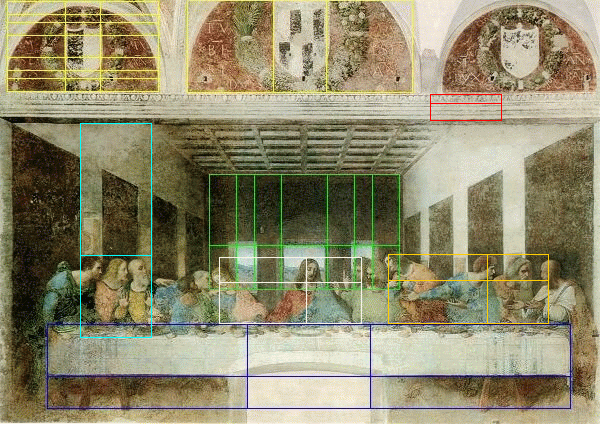Although science is largely based off of mathematics, art is typically
not associated with math in the same way. However, as this week has shown, math
and art are much more connected than I had previously thought.
Take the golden ratio for example. This mathematical concept has played a major role in architectural achievements such as the Parthenon and the pyramids of Giza. Moreover, it can be found in nature. Most notable examples include shells or plants, but it can also be seen in the small structures of DNA and in the vast spiral galaxies of the universe. With the discovery of this ratio, artists had the ability to use this harmony found from nature and math in their own works.
Take the golden ratio for example. This mathematical concept has played a major role in architectural achievements such as the Parthenon and the pyramids of Giza. Moreover, it can be found in nature. Most notable examples include shells or plants, but it can also be seen in the small structures of DNA and in the vast spiral galaxies of the universe. With the discovery of this ratio, artists had the ability to use this harmony found from nature and math in their own works.

(http://memolition.com/2014/07/17/examples-of-the-golden-ratio-you-can-find-in-nature/)
Often times, math helps to shape the way
artists perceive their world. For instance, before al-Haytham’s Book of Optics,
art was drawn flat without much depth. However, the introduction of the
vanishing point caused a new renaissance of art being more realistic,
three-dimensional, and detailed. Leonardo’s Da Vinci’s The Last Supper illustrates
this point by making the painting feel lifelike. The use of vanishing point
enhances the focus of Jesus at the center. The Last Supper is also an important
piece for its use of golden ratio, creating the natural harmony as noted
earlier. It is iconic as it is fundamental in showing how natural elements and
mathematics can be used to improve what the artist wants to convey.


Da Vinci's The Last Supper uses both the golden ratio and the vanishing point.
(http://www.artmumble.com/2012/02/single-vanishing-point-in-leonardo-da.html, http://www.goldennumber.net/art-composition-design/)
Beyond 2D and 3D perspective, math has also helped to
explain the fourth dimension. As Abbott’s Flatlands shows, the fourth dimension
can be argued by “the Argument of Analogy of Figures”. Even if it cannot be
seen in the real world, it can be imagined in a metaphysical one. This idea
would eventually find a scientific answer in Einsteinian relativity to create
“four-dimensional images of an intricacy and accuracy never dreamed of”
(Henderson), but this by no means made the artists’ contribution insignificant.
Just the thought of the fourth dimension helped to shape new forms of art like
cubism.

(https://en.wikipedia.org/wiki/Tesseract)
Alone, math is just a set of numbers and calculations.
However, it has become an essential tool for the arts and the sciences. Without
it, art and science would be stagnate and unchanging. In the end, I realize
that math improves these two disciplines to constantly reach new heights by
finding hidden meanings within the world.
Sources:
Abbott, Edwin A. Flatland: A Romance of Many Dimensions. 1884. Print.
Da Vinci, Leonardo. The Last Supper. 1495-1498. ArtMumble.com. 13 Mar. 2012. Painting. 25 June 2016. <http://www.artmumble.com/2012/02/single-vanishing-point-in-leonardo-da.html>.
"Examples of the Golden Ratio You Can Find in Nature." Memolition. 2014. Web. 25 June 2016. <http://memolition.com/2014/07/17/examples-of-the-golden-ratio-you-can-find-in-nature/>.
Frantz, Marc.
Lesson 3: Vanishing Points and Looking at Art. 2000. Print.
Henderson, Lynda. “The Fourth Dimension and Non-Euclidean Geometry in Modern Art.” Leonardo 17.3 (1984): 205-210. Web. 25 June 2016.
Meisner, Gary. "Golden Ratio in Art Composition and Design." Phi 1.618: The Golden Number. 4 May 2014. Web. 24 June 2016. < http://www.goldennumber.net/art-composition-design/>.
Tesseract. Digital image. Wikipedia. Wikimedia Foundation. Web. 26 June 2016. <https://en.wikipedia.org/wiki/Tesseract>.
Vesna, Victoria. "Mathematics: Zero, Perspective, Golden Mean." YouTube. uconlineprogram. Lecture. 24 June 2016. <https://www.youtube.com/watch?v=mMmq5B1LKDg>
I agree with you that math can be found in the nature. Our nature has hundreds of millions creatures out there, and math patterns are everywhere embedded in a way that is not obvious to us. And indeed that math helps us to make art works, especially in computer programs. All the computer animations are created using hundreds of mathematical transforms on the pixel matrix.
ReplyDelete